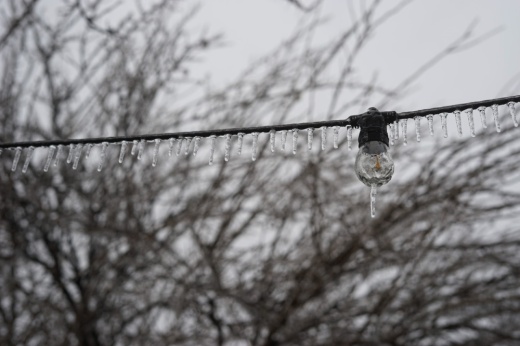After hundreds of thousands of Austinites were left without power in this winter’s ice storm, officials are eyeing local electrical reliability improvements amid ongoing reviews of the city’s storm response.
How we got here
The widespread and extended power outages in February were mainly attributed to freezing weather that packed heavy ice onto trees and power lines, leading to challenging restoration efforts over the course of around two weeks.
That situation and other communications and operational issues during the weather event have so far prompted an internal review of Austin Energy’s storm response and a council-ordered audit of AE’s tree-trimming work. Council’s building dissatisfaction with former City Manager Spencer Cronk’s oversight of Austin’s storm response also contributed to his firing.
While more information on AE’s performance will be detailed in the utility’s own after-action report coming later this year, council on March 23 will ask for further consideration of two topics that were raised in the storm’s aftermath: burying power lines and ensuring backup power is available for critical city services.
Underground options
Power lines can be seen running aboveground throughout most of Austin, but the city already has an extensive belowground distribution network as well. According to council information, AE’s system includes around 5,000 miles of overhead lines and 7,000 miles of underground lines. The utility has progressed from having around 37% of its lines underground in 1997 to 58% in 2021.
During February council briefings on the storm, several officials expressed interest in burying more of Austin’s distribution system given that AE linked the most severe outages to complications with overhead lines.
A resolution from District 2 Council Member Vanessa Fuentes asks for more consideration of building underground power lines alongside all city infrastructure projects going forward, including major corridor improvements and the upcoming Project Connect transit system. Areas with a history of outages or near critical facilities could be prioritized as trial locations for the transition.
“Last month’s ice storm served as another wakeup call to the threat of climate change facing our communities. Austinites deserve to feel safe and assured that our city’s infrastructure is prepared to handle any extreme weather event,” Fuentes said in a statement.
A separate resolution from District 5 Council Member Ryan Alter asks for further consideration of the issue. His proposal asks the city to take on a feasibility study and draft a long-range spending plan for moving overhead lines underground in places deemed to be a priority—such as infrastructure, emergency or health care facilities and underserved areas—but that are not expected to see high levels of new development anytime soon.
Alter's resolution also asks the city to promote burying lines on both public and private projects and in city land-use regulations.
“My item and the item sponsored by Councilmember Fuentes are complementary to one another. My resolution includes a feasibility study and long-term planning for both high-priority uses and for areas without new construction opportunities. While people are understandably frustrated after losing power repeatedly in recent years, with these combined efforts we are taking action in the way that our community should expect," he said in a statement.
Such efforts may require city leaders to find a balance between construction costs and power reliability. Underground lines can be less susceptible to weather disruptions, but AE officials estimated them to be 10 times more expensive per mile than overhead lines. AE GM Jackie Sargent said burying the city's distribution lines would be disruptive in the community and “prohibitively” expensive, likely totaling several billion dollars.
Michael Webber, a professor of mechanical engineering at The University of Texas at Austin and a former AE commissioner, told Community Impact in February that buried lines would likely produce a local electric network that is less likely to fail, but at a higher price tag.
“It’s a tradeoff between upfront costs, repair costs and the benefits of a more reliable grid,” he said.
Sargent told council in February that no firm analysis of the costs of that work in Austin has ever been conducted, and that she planned to request funding later this year for AE's own feasibility study.
Backup capacity
A separate measure sponsored by Mayor Pro Tem Paige Ellis for council consideration March 23 would launch a review of Austin’s emergency backup power system.
Despite a heightened focus on local power reliability since 2021’s Winter Storm Uri, some Austin first responders were left in the dark during this year’s Winter Storm Mara. Ellis’s resolution states that many Austin Fire Department and Austin-Travis County EMS stations across the city lost power in the February ice storm and did not have working backup generators available—even after officials had set aside new funding for generator improvements.
“[D]ue to age or pending maintenance, some AFD and EMS stations with access to emergency back-up power during Winter Storm Mara were forced to operate at a limited capacity, depriving some on-duty first responders access to warm water, kitchen facilities, battery charging, and other essential aspects of living on site,” Ellis’s resolution states.
The proposal calls for the city to conduct an inventory of all generators at Austin fire and EMS stations, including a review of equipment reliability for basics like heating and lighting.
If the resolution is approved, a report covering that information and plans for station-by-station upgrades as needed would be due to council July 1.





